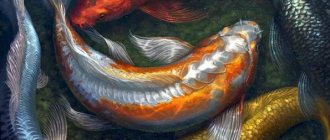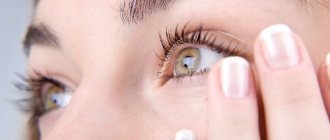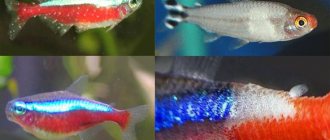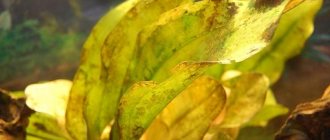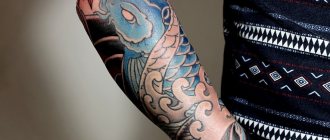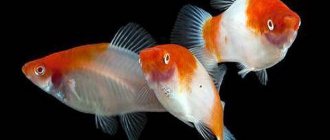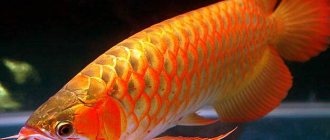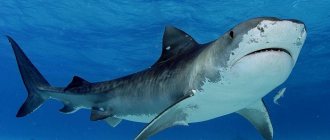Koi were developed in Japan through selective breeding . The very nature of this process means that koi are related to thousands of other fish, bred from a relatively small adult population. This in turn means that for some of them, resistance to disease can become a real problem. Genetic diversity is countered by attempts to standardize the color and size of fish.
Many koi often live in very unsuitable conditions, often in reservoirs intended for silver carp. Such ponds have a depth of only 60 cm, which is not enough for koi, since they need a depth of at least 120 cm.
Water quality also plays an important role in the life of koi . Water problems are most often associated with overpopulation of a reservoir. This means that in densely populated bodies of water, pathogens and pathogens will quickly find their target.
All these factors cause stress in fish, which increases the release of cortisol into the blood, which negatively affects the immune system. Also add that at low temperatures (in spring) immunity is significantly reduced.
Article on the topic Koi Ulcers
Habitat
Fish from the carp family are omnivorous and unpretentious. Acclimatized in Europe, Asia, Australia and North America. This is a fast-growing, heat-loving fish that lives in low-flow, fresh or slightly brackish water bodies. The optimal temperature regime for intensive growth is 16 – 30°C. When the temperature drops, the growth rate slows down, at 6–8°С it stops, at +2…0°С the fish falls into an anabiotic state. Juveniles from 5 g and adults feed on benthos and fish feed. Carp reaches marketable weight at 1.5 - 2.5 years (500 - 1000 g or more).
Maintenance and care
It’s worth saying right away that among the features of keeping koi, the main one is the large size of the container. Carps are not aquarium fish, but pond fish, so the most optimal conditions are in a pond. Its size should be approximately this: per centimeter of body length of the fish, 5 liters of water. The same formula also works for keeping koi carp in an aquarium.
You can create a pond yourself on your own site. The requirements are simple:
- Depth 1.5 m, water volume from 8 tons (standard parameters for such a volume are 3x2.5 m).
- The bottom can be made of either film or concrete
- It is better to organize a drainage system around the pond so that melt and rain runoff does not get into the water
- Sunlight is needed constantly
- Well water is suitable, but clean
- Pond filtration according to volume
- It is advisable to organize a flow
As for the aquarium for koi, the parameters for maintenance and care at home are as follows:
- The volume of the aquarium is at least 500 liters (preferably 1-2 tons)
- The shape of the aquarium is shallow, but long, so that there is room for swimming. With such volumes, the aquarium will look either like a pond or like a room decoration system (for example, an artificial river is laid along the wall). The form can be standard.
- Temperature 15-30°C.
- Hardness 4-10
- Acidity 7 – 7.5
- The water can be refreshed once every three weeks, while simultaneously cleaning the soil with a siphon.
- Any soil, not very small and not very coarse.
- The decor must be firmly secured. Koi carps are good decorators, capable of completely changing the interior in a few hours: rearranging small objects and digging up plants (and even nibbling on living ones)
Infectious diseases
Viral (spring viremia of carp,
VVK, Spring viraemia of carp, SVC). A highly contagious disease that occurs in the spring and summer and is characterized by abdominal dropsy, exophthalmos, hemorrhagic diathesis and degenerative-necrobiotic changes in the internal organs. With massive infection, 40 to 70% of the fish stock can die.
Treatment of viral diseases and prevention with vaccines have not been developed. However, bacterial complications can be eliminated through the use of antibacterial drugs from the Antibak series for fish of all species and age groups.
Description
Koi are a large ornamental species of carp. It has a classic body shape for a fish - oblong, spindle-shaped, with round, well-fed sides. If you look at a koi carp from above (and this is usually how you have to contemplate them), you can see that the body is more massive in the head area and then tapers towards the tail, as if in the shape of a drop. The eyes are round, black, and protrude slightly. The mouth is large, opens wide, with two small processes on the sides. The fins are powerful, dense, but not too large. There are different sizes - from 15 cm to almost a meter. Depends on the volume of the home. But don’t expect your koi fish to remain small in a small aquarium. It’s just that over time it will become very cramped.
Bacterial infections.
It is necessary to treat fish infected with pathogenic bacteria using broad-spectrum antibacterial drugs.
Aeromonosis (causative agent
Aeromonas hydrophila )
. Occurs in spring and summer. It manifests itself as an enlarged abdomen, serous-hemorrhagic inflammation of the outer integument, fins, bulging eyes, ruffled scales or the formation of subcutaneous blisters, and impaired coordination of movements.
Ulcerative form in chronic disease
Myxobacteriosis
– widespread bacterial diseases of freshwater fish when they are grown in conditions of intensive fish farming (cage, pool, warm-water farms). They are more common in juveniles and manifest as damage to the gills and skin of fish. To combat bacterial diseases, antibacterial drugs from the Antibak series are used.
Instead of an afterword
As we can see, carp are susceptible to many different diseases, some of which are dangerous to humans and some that are not. Be that as it may, when purchasing fish, especially in markets, be attentive to its appearance. Although external well-being does not always reflect the real state. If you have any suspicions when cooking at home or you find parasites, it is better not to eat such fish, since you yourself will not determine the degree of its danger; this requires a specialist and clinical examinations.
Fungal diseases
Branchiomycosis (gill rot) is a disease caused by the fungus Branchiomyces sanguinis, manifested by damage to the gill apparatus of fish. The pathogen affects large blood vessels, causing thrombosis and subsequent necrosis of the gill filaments. The main methods of combating branchiomycosis are the normalization of living conditions, disinfection and reclamation measures.
Saprolegniosis is a mycotic disease of most fish species, caused by opportunistic aquatic fungi from the class Oomycetes. Saprolegniosis affects pond fish of all age groups, but the most severe disease affects young carp during wintering in ponds, wintering complexes, cages, etc.
Behavior and Compatibility
It is better not to combine koi with other fish. It's not that they are aggressive, quite the opposite. They are peaceful and funny inhabitants of water bodies, do not fight for territory and do not eat others. But since koi are a borderline species between pond and aquarium fish, it will be difficult for them to find someone to be their neighbors. Koi are large, agile and good-natured. Fish of equal size to them are likely to become a danger to koi. Smaller fish will feel uncomfortable around them. Therefore, the ideal content would be a monospecies aquarium or pond.
Parasitic diseases
The main invasive fish diseases are caused by parasites, which include protozoa, helminths, and crustaceans.
Inflammation of the carp swim bladder (SVP)
– an invasive disease caused by myxosporidium from the family Sphaerosporidae, characterized by serous-hemorrhagic and purulent inflammation of the swim bladder. Carp, carp, their hybrids and crucian carp aged 4 weeks and older are affected, the most severely affecting young of the year and two-year-olds. Opportunistic bacteria (mainly of the genera: Aeromonas, Pseudomonas, etc.) complicate the course of the disease. To combat bacterial complications, the drug “Antibak 100” is used.
Gelatinous yellowish-gray coating on the swim bladder
Bothriocephalosis
caused by cestodes from the Bothryocephalidae family. The location is the intestine. Bothriocephalosis of freshwater fish is common in many carp ponds and natural reservoirs of the country. Economic damage consists of losses resulting from slower fish growth, decreased fish productivity in water bodies, and, less commonly, increased mortality of juvenile fish.
Botryocephalus in the intestines
Cavious
is an invasive fish disease caused by the cestode Khawia sinеnsis from the family Caryophyllaidae, which parasitizes the intestines of carp, carp, black and white carp.
For the treatment and prevention of bothriocephalosis and caviosis of carp fish, the drug “Phenomix” is used at a dose of 0.5 g/kg fish weight in a group method with food. A mixture of feed with the drug is prepared at a feed mill using any granulation or extrusion modes, or on the farm by introducing the drug into the feed at the rate of 25 kg/t of feed and fed to the fish as a single dose in the amount of 2% of their weight. Or a mixture of food with the drug is prepared in similar ways at the rate of 10 kg/t of food and fed to the fish in an amount of 5% of their weight in fractions throughout the day. Alben granules are also used at a dose of 0.2 g per 1 kg of fish once a day for two days in a row.
Philometroidosis
– is one of the most common diseases, caused by round helminths Philometroides lusiana and is recorded in all fish farming areas. In the southern regions, phylometroidosis occurs more often and with greater intensity of invasion. The disease affects carp, carp, crucian carp and other fish of all age groups, but more often two- and three-year-old scaly carp.
For therapeutic and treatment-and-prophylactic purposes in case of phylometroidosis of carp, the drug “Filomed” is used in a mixture with food using the method of free group feeding in a daily dose of 0.5 g per 1 kg of fish weight twice with an interval of 24 hours. The required amount of feed is calculated taking into account its daily consumption by fish in the reservoir.
Female phylometra under carp scales
Types of koi carp
Koi fish, whose second name is brocade carp, come in many varieties. All koi species are artificially bred and have many requirements. They differ in color. All varieties of koi carp are called nishikigoi. To date, according to the description, they do not officially include veiled and ghost koi.
- Kohaku - the main body color is white, the spots on the back and sides are dark orange or red. The spots are shapeless, but have clear edges.
- Ogon is a koi carp without spots. Body color can be red, rich orange, yellow or gray-white.
- Asagi is a koi with a blue back and red sides. The head is white, red goes to the fins where they connect to the body.
- Gosiki - white body color is complemented by very large red spots.
- Koromo is a white base color with red spots interspersed with black markings.
- The veiled koi has a longer body compared to other veil finned koi.
- Taisho sanshoku, sanke - the main color of the scales is white, on it there are large red and smaller black spots.
- Kumonryu is a white fish with small black spots.
- Shusui is a koi with a blue back (its large scales are outlined in shades), and large red spots on the sides. The background is white, the head is also white, maybe with red spots.
- Utsurimono - black carp with red spots or red with black spots - usually the amount of both shades is the same. The fins will help determine what the main color is.
- Showa Sanshoku - The main body color of this koi is black, with large spots of red and white.
- Bekko - on the main background (which can be any color, white, red or yellow) there are small fuzzy black spots.
- Hikari moyomono - has a golden tint of scales and a special silvery shine. The spots are large red-orange.
- Kinginrin - This fish has a back covered with silver scales, but the body also has the main colors of koi - red and white.
- Ghost Koi - has a larger body and smaller fins, it does not have the grace inherent in regular koi.
The word tancho may be added to the names of breeds. This means that the fish has a large red spot on its head (for example, tancho kohaku). Other colors that cannot be classified as one of the descriptions are called Kawarimono or Kawarigoi.
There is a type of carp that has specific scales: they either have none at all, or they have two rows. These fish are called Deutsugoi (carps from Germany).
Non-communicable diseases
Carp diseases caused by non-pathogenic factors are divided into 2 groups: nutritional and toxicoses.
- Nutritional.
They occur when using unbalanced or low-quality feed, contaminated with opportunistic microflora. Individuals of all ages are affected. Growth rates are reduced, and part of the population may die. - Autogenic toxicosis
. Non-contagious branchionecrosis is associated with the release of organic wastewater from agricultural enterprises into water bodies. It can also be caused by autointoxication with the end product of protein metabolism of fish due to crowded housing and violation of sanitary standards. Causes necrosis of the gills and, in some cases, mass death.
In order to improve the health of reservoirs, they increase flow, provide aeration, and lower the pH and temperature of the water. This leads to an increase in the intensity of water exchange and the oxidation of toxic products.
Are fish diseases dangerous for humans?
Diseases of carp fish can be dangerous to people. In addition to known helminthiases, fish can sometimes cause toxic infections in humans.
The main sources of the spread of the disease are uncontrolled transportation from not entirely prosperous farms to good ones. Other diseases are focal in nature. This suggests that in some regions of the country wild fish are carriers of foci of infection, living in natural reservoirs. It is almost impossible to make your farm healthy in such an area, because transportation from such a region to a healthy body of water will lead to contamination. Veterinary certificates, unfortunately, do not always reflect reality. In general, cases of diseased fish being brought into healthy bodies of water have become more frequent, which may well lead to the collapse of the entire economy. This is very dangerous for those structures that organize fishing trips.
Since there are carp diseases that are dangerous to humans, you need to be careful when choosing fish.
Branchiomycosis
An infectious disease of pond fish caused by a microscopic fungus. The causative agent Branchiomycosis destroys gill tissue. Fish with Branchiomycosis refuse to feed, accumulate near the shores, rise to the surface of the water, and assume a vertical position. The disease usually occurs in the summer, lasts 2-8 weeks and causes massive death of fish. Water bodies are quarantined, sick fish and corpses are caught and destroyed. In spring and autumn, ponds are disinfected with bleach or quicklime.
Motherland
The descendants of the wild Amur carp, koi carp or brocade carp, went through a multi-level selection system and spread throughout the world. The first carp came to Japan with Chinese settlers in the 14th century.
The Amur carp is the faded wild ancestor of the koi carp.
At first, fish were kept in artificial reservoirs solely for food. During the process of genetic mutation, individuals appeared with colors that did not correspond to the species. Such fry were kept for decorative purposes.
Ponds with brightly colored carp can be seen in private gardens, public parks, and near temples. The Japanese love to relax and meditate while admiring the fish.
Ponds with koi are not uncommon in eastern countries, but recently these fish are increasingly conquering ponds in our country!
The breed was officially presented to the public by breeders from Niigata at an exhibition in 1914, after which fish lovers from other countries became interested in the conditions for keeping koi carp. Americans and Europeans became more familiar with this entertaining breed after 1945, when Japan became more open to the world.
Koi carp have a dense, elongated body with proportional fins and a head. Two small antennae are visible above the upper lip. Single tail.
Specimens with shiny skin, clearly defined spots, compatible color areas, evenly distributed over the body are valued.
The color shades of brocade carp vary depending on the illumination of the reservoir, the composition of the water, and the dyes used with the food. In ponds, pets grow up to 40–100 cm, with an average weight of 5 kg.
The beginnings of intelligence have been observed in Japanese koi carp. Communicating daily, they distinguish the owner from other people. They feed from hands, allow themselves to be petted, without experiencing anxiety. They show training abilities and are able to carry out up to 20 commands.
The fish live at a depth of 50 cm from the surface and do not go below one and a half meters. They are calm and friendly in nature and do not show aggression. With proper care and maintenance, they live up to 30 - 50 years.
Keeping carp in an aquarium requires a jar volume of at least 500 liters.
In an aquarium, the size of fish is more modest - 20–30 cm, and their lifespan is also reduced to an average of 30 years.
Under natural conditions, koi carp feed on insects, larvae, and aquatic plants.
Is it possible to eat koi carp?
Ornamental koi carp are a variety of common carp, so their meat can be included in the diet. But for the sake of preserving the species, the Japanese did not forget to feed their pets in hungry, lean years; breeders maintained the purity of the breed and developed new species, sacrificing personal interests.
It is neither appropriate nor advisable to treat koi as a food product. Decorative fish are not cheap. For this price you can buy tens of times more carp. Although koi carps are edible.
Feeding
Koi carps are considered omnivorous fish and readily eat both plant and animal foods. They need to be fed three times a day, giving food in small portions, eaten within 5-10 minutes.
The daily food intake should not exceed 2-3% of the body weight of the fish itself. The food should not dissolve in water or sink to the bottom, provoking rotting processes.
When kept in a pond, the diet of koi carps should include brine shrimp and bloodworms, tadpoles and frog eggs, worms and shrimp, cyclops and daphnia. If the fish live in an aquarium, it is more convenient to give them ready-made commercial food such as Tetra Pond Koi.
They contain all the necessary nutrients, vitamins and microelements, as well as additives to enhance color.
On a note. Koi carps are smart fish that quickly get used to their owners and allow themselves to be petted. Pets are quite amenable to learning, and if you lightly tap on the glass of the aquarium before feeding, they will quickly remember this.
Gill disease of unknown etiology (GILLD) or gill necrosis
Gill disease of carp is one of the most dangerous diseases that can cause mass mortality of farmed fish. The disease appears in early and mid-summer and subsides by autumn. Most often, two-year-old carp are affected.
The causative agent of the disease has not been identified. Gill disease of unknown etiology must be distinguished from branchiomycosis. The clinical signs of these diseases are largely similar. There are hypotheses about the viral and bacterial nature of the disease. It has been noted that the disease is often provoked by disturbances in the hydrochemical regime, primarily by an increased content of ammonia nitrogen and organic matter. Preventive measures aimed at creating favorable growing conditions are effective. It is recommended to use bleach or calcium hypochlorite, as well as quicklime. Quarantine restrictions are imposed on farms affected by gill disease. The disease can cause significant waste of live fish.
